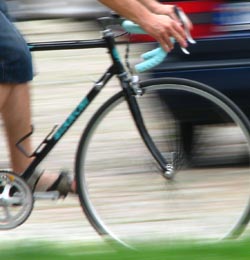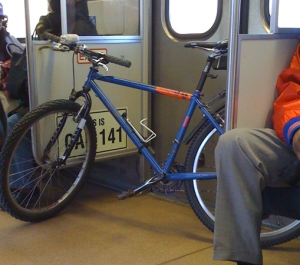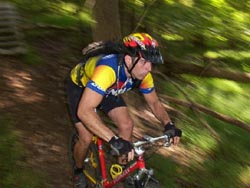
This time of year, everyone’s talking about the changes they didn’t get to keep last year, maybe the year before that, too. This New Year’s, maybe I can help you cross one of your resolutions off the list.
If you’ve made the resolution to live healthier, using one of the many car alternatives, like public transportation or biking, may be a good place to start. You can relax instead of stress about traffic, maybe read a book (was “Read more” also a resolution?), and you’ll have the chance to look up and appreciate the view. I’ve been a regular bike commuter for about 15 years, not including elementary school. It’s great exercise and an invigorating way to start and end the day. If your commute is less than 3 miles to your office downtown, it will probably take you the same amount of time whether you ride a bike or drive, but you won’t have to go to the gym that day.
For the last 5 years, I’ve been using a combination of my bicycle and the Baltimore Metro to travel the 10 miles downtown. Many in Baltimore don’t even know we have a subway, so if that’s you, you’re not alone. It covers only limited parts of the city, but at least it’s clean and relatively safe. Here’s a little info to get you on your way.
Public Transportation (MTA)
The Metro parallels Reisterstown Road and the Light Rail follows Falls Road. They cross each other downtown, but they never meet, which seems to me a pretty significant oversight. However, if you’re working downtown, these can both be good options to get you to work.
Bicycles are permitted on both the Metro and Light Rail whenever the cars aren’t packed with passengers. That’s great, because the DC Metro has restrictions which completely prohibit bikes during rush hour. Since coverage of the city is limited, being able to take bikes on the Metro, Light Rail, and buses is really helpful to really open up the system to a wider area. It seems that the MTA has the right idea:
“Public transportation and bicycles provide more mobility options to everyone, helps improve air quality and reduces traffic congestion. In Maryland, public transportation and bicycles can and do work together to allow for longer trips. That’s smart transportation – the ability to move seamlessly between transit modes in a healthy enjoyable manner.”

Storing my bike on the Metro
Although there are no specific accommodations for bicycles on the Metro, there are racks on the front of the buses to make carrying bikes simple. However, the Metro cars are rarely full, so I can just lean my bike out of the way against the far doors and take a seat. You may have to experiment with your ride, but placed properly, mine is secure enough to manage the whole ride by itself without falling over.
Tickets, please
Fare passes for the MTA system are available in a variety of configurations, and bikes are always free. I usually opt for the Single Trip pass because there are no discounts offered for the 5-day commuter, and I only use the Metro. However, weekly and monthly passes offer unlimited service on the Metro, Light Rail, and buses if you need to combine modes to get around town. The machines take change and bills, but they will only provide change up to $16.50, so if you only have a $20 bill, a day-pass is your best option. As I understand it, the capability of accepting credit cards or a debit card similar to an EZ Pass are in the works, but it is not available, yet.
If you’re bringing your bike, aim for the handicapped accessible turnstile. It’s wider, and the MTA prefers it. By the way, keep your ticket after you enter because you’ll also use it at the exit turnstiles.
By the time you get to the train platform, it’s easy to become a bit disoriented, especially underground. There are signs on the far side of the train that show you where you are (the dot) and where the train is headed (left). Trains normally pass each other on the right unless there is a problem on the tracks. To be sure, each train also has signs on the front and side that say either Johns Hopkins or Owings Mills to let you know to which end of the line it’s headed.
It’s like riding a bike
You probably remember how to ride a bike, but there is plenty left to learn about safely riding a bike in traffic. If you want to ride a bike to work, Washington State has posted a fairly comprehensive guide to help you get home safely. Remember, you don’t need to spend $1,000 on gear to get started. You really just need an old bike in good working order and a good helmet. The Velocipede Bike Project is a good place to start if you need to get your bike tuned up because they’ll teach you how to fix it yourself. The rest depends on your preferences. If you can’t bring your bike inside at the office, you’ll need a sturdy lock. And, if you’re starting right away, you’ll need some warm gloves, bright/reflective clothing, and a lighting system.
Depending on your pace and the distance covered, it really is possible to arrive at work without being drenched in sweat. Bikers also pack their office clothes and ride in something more appropriate (spandex are rarely appropriate). Alternatively, you may have a shower at your office or find a nearby gym that offers a “shower membership”.
And, my #1 tip for riding in traffic: Assume you are invisible. You’re not invisible, and I don’t run around believing I’m invisible, either. But, unless you see evidence to the contrary, it’s a safe bet to assume the driver of that bus doesn’t see you. Don’t be shy – ride defensively and feel free to yell.
Let’s get started
The hardest part about changing a habit is getting started. First, accept that you can do it, then do it.
Good luck. Let me know how it goes. And, if you live in Baltimore and want a hand getting started, I’d be happy to join you on your first commute.
Disclaimer: Riding bikes in traffic can be dangerous. Life can be dangerous. Use your own judgement before partaking in any activity.












